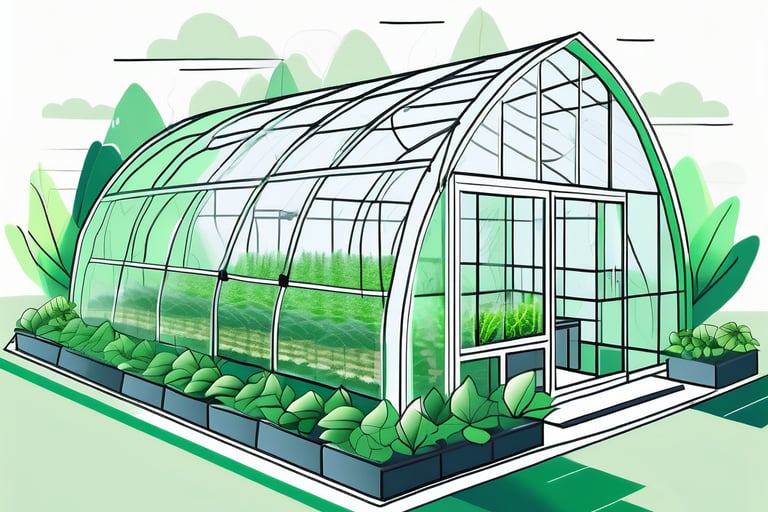RNAGRI AGRO SOLUTIONS PRIVATE LIMITED
1. Poly house structure design and manufacturing knowledge
Polyhouse structures are designed to provide a controlled environment for crop cultivation, extending growing seasons and improving yields. The design typically involves selecting the right type of structure, such as tunnel, gable, or Venlo, based on crop needs and climate. Frames are usually made from durable materials like galvanized steel or aluminum, while coverings are commonly polyethylene film or polycarbonate sheets, chosen for their insulation and light diffusion properties. Effective ventilation is crucial, with options including natural vents or mechanical systems like fans. Climate control features, such as heating and cooling systems, help maintain optimal growing conditions. The manufacturing process includes detailed planning, constructing the frame, installing the covering, and setting up irrigation and ventilation systems. Regular maintenance ensures the polyhouse remains effective and safe for crop production.
2. Mist chamber climate control
A mist chamber is a climate control system designed to regulate humidity and temperature in polyhouses and greenhouses. It operates by dispersing fine water droplets into the air through high-pressure misting nozzles or ultrasonic foggers, which evaporate quickly to increase humidity and lower temperatures. This system helps create an optimal growing environment by enhancing moisture levels, cooling the air, and maintaining consistent conditions. Integrated with fans and ventilation systems, a mist chamber ensures even distribution of mist and prevents excessive moisture buildup. It offers energy-efficient cooling and customizable settings for various crops, while regular maintenance is necessary to clean nozzles and ensure system functionality.
3. Natural ventilation poly house NVPH
Natural ventilation polyhouses (NVPH) use passive airflow to manage temperature and humidity without mechanical systems. They feature side vents and roof vents that work together to create airflow; cooler air enters through the side vents, while warmer air exits through the roof vents, leveraging thermal buoyancy and cross-ventilation principles. This design promotes energy efficiency by reducing reliance on mechanical cooling and helps maintain optimal growing conditions for plants. Proper placement and maintenance of vents are crucial to ensure effective ventilation, though the system's performance can vary with climate and may require additional cooling in extreme conditions.
Applying for government schemes and subsidies for agricultural projects involves several steps. First, research the relevant schemes for your needs, such as polyhouse construction or seed production, and ensure you meet the eligibility criteria. Prepare necessary documentation, including business details, a project plan, financial statements, and any additional required papers. Obtain and complete the application form from the relevant government department or online portal, then submit it along with the supporting documents. After submission, track the application status and respond promptly to any additional queries. Once approved, follow the guidelines for utilizing the funds or subsidies and ensure compliance with any reporting requirements. Consulting with agricultural experts can also help navigate the process effectively.
5. Greenhouse croup management vegetables & horticulture
4. Government schemes and subsidies apply & form submission
Greenhouse crop management for vegetables and horticulture focuses on optimizing plant growth and ensuring high yields through meticulous environmental control and care. It involves regulating temperature, humidity, and light levels using heating, cooling, and lighting systems to create ideal growing conditions. Efficient watering and irrigation systems, such as drip or sprinkler systems, maintain consistent moisture and water quality. Nutrient management is critical, with tailored fertilization and regular monitoring to meet crop needs. Pest and disease management employs integrated strategies, including biological controls and preventive measures. Crop rotation and diversity help maintain soil health and reduce disease risks. Effective harvesting and post-harvest handling preserve crop quality and extend shelf life. Detailed record-keeping and data analysis support continuous improvement in greenhouse operations.
AGRI AGRO INTERNSHIP TRAINING PROGRAM


POLY HOUSE GREENHOUSE TECHNOLOGY
About Agri Agro Grand Expo
Agri Agro Grand Expo International has served as a platform for bringing together many foreign as well as national visitors from all over the country to interact with leading national agriculture technology companies. The Agriculture Expo, held annually, is one of the leading national agriculture events of its kind, showcasing cutting-edge agricultural technologies. This exhibition in India traditionally attracts numerous Ministers of Agriculture, decision-makers, experts, practitioners, and trainers in agriculture, along with thousands of visitors from around the country.
contact :
expo@agriagro.in
exposulabh@agriagro.in
+91-9520099666
+91 -70601 71734
+91 -8791144200
© 2026 Agri Agro Grand Expo All rights reserved.
Mail:
